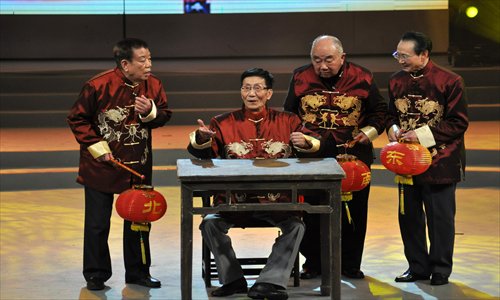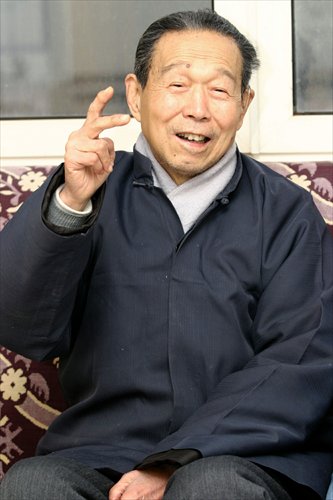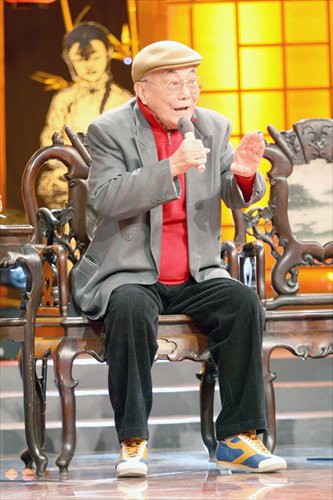HOME >> METRO SHANGHAI
A good long laugh
By Yang Zhenqi Source:Global Times Published: 2013-12-24 16:58:01
Editor's note
From a fishing village with a population of just 200,000 in 1843, Shanghai has developed into a huge modern city where more than 23 million people live. From the time Shanghai was forced to open up as a port in 1843, the city has witnessed remarkable change and progress. This year marks the 170th anniversary of Shanghai's opening-up and in this special series of reports, the Global Times will highlight some of the crucial moments, recall some choice memories of olden days and uncover some of the secrets of the city. Don't miss these exciting insights into the metropolis.

"Policemen aspire for a harmonious society so they will not be required to deal with crimes."
"Good."
"Burglars have the same ambition."
"How's that?"
"Well one day the police won't be needed any more and will all be dismissed. Then the burglars can get on with their work."
This is a joke from Aspiration, one of many original modern routines created by the Xiao Pengyou Shanghai Farce Studio, an amateur theater group dedicated to promoting the traditional Shanghai farce comedy style for the city's younger audiences.
Now officially listed as one of the city's intangible cultural heritages, Shanghai farce (huajixi) is a unique traditional comedy performance style that originated in Shanghai in the early 20th century and flourished in the Yangtze River Delta region thereafter.
Theatrical elements
Shanghai farce includes influences from Chinese regional operas and Western comedy and has become its own comprehensive performing art. It can involve monologues, dialogues, improvisation, mime, traditional opera, folk dancing and singing and other theatrical elements.
Performed in the Shanghai dialect, a Shanghai farce show is usually based on current affairs and city gossip and involves characters from all walks of life. While it is created to entertain and make an audience laugh with its satirical and broadly drawn characters, huajixi has also reflected the different periods of the city's history as it has evolved through nearly 100 years.
Shanghai farce is believed to have evolved from dujiaoxi, a folk art form involving talking and singing by Shanghai street vendors promoting their pear paste candies. As well as these candy-seller performers, other vendors used songs and routines to tout their products.
After years of combination and assimilation, these different forms gave birth to a new art form, dujiaoxi, which was based on comedy and farcical situations. Dujiaoxi was closely associated with Wang Wuneng, a famous Shanghai comedian. In 1927, Wang placed advertisements in local newspapers promoting his upcoming comedy shows. He went on to stage a series of dujiaoxi shows on his own.

One-man shows
The success of these shows not only prompted Wang to perform more dujiaoxi, but also inspired a group of imitators who staged similar shows at various venues in Shanghai between the 1920s and the 1930s. They were mostly at this stage one-man shows, with the performer creating a series of characters throughout the evening.
At first dujiaoxi was being performed in two styles - as stand-up routines or as musical performances. The stand-up variety involved the performer relating a story or a succession of gags, much like today's comedians but in South China dialects or accents. The musical variety used songs sung in dialects and accents and involved folk tunes and local references. After a few years most dujiaoxi performers combined both these styles in their acts.
Given the nature of dujiaoxi, these one-man shows were much more than stand-up routines with performers merely speaking to an audience. These performers had to master dialects and accents so they could deliver tongue twisters and word play from a dozen different regions. They also had to master mime techniques and movements as well as vocal styles from Peking Opera and the other opera styles of South China.
More versatile
They were much more versatile than most of the more stylized actors and opera singers of the day and their faces and bodies could twist and turn in a flash to create a new mood or atmosphere. They were quick-witted and could seize on an audience reaction to turn a giggle into uproarious laughter. They blended basic elements of humor with biting satire and political commentary.
Apart from Wang Wuneng, Jiang Xiaoxiao and Liu Chunshan were two other acclaimed dujiaoxi artists in prewar Shanghai. However the outbreak of the War of Resistance against Japanese Aggression (1937-45) and the Pacific War in 1941 changed the demographic of the dujiaoxi scene in Shanghai.
The one-man shows became more involved as the original solo dujiaoxi performers found themselves having to join other theater companies and troupes to survive. This, in turn, resulted in more elaborate productions involving more than one performer but retaining the spirit and comedic style of the original. Shanghai farce gradually took shape from these early performances and grew in popularity over the following years.
The founding of the People's Republic of China in 1949 also marked the beginning of a golden age for Shanghai farce. To celebrate the birth of the new China, a number of propaganda comedies in the Shanghai farce style were created, most of which mirrored the social progress and reforms of the time. The Apprentice San Mao and The Seventy-two Tenants were two of the most famous pieces.
Premiered in 1956 by the Shanghai Dazhong Farce Troupe, The Apprentice San Mao follows the wretched life of a poor orphan, San Mao, who is exploited and abused by bosses during his apprenticeship in old Shanghai. San Mao finally manages to escape from the cruel overseers to live a happy, new and free life.
The Seventy-two Tenants was produced by the Shanghai Dagong Farce Troupe in 1958. It tells the poignant, bittersweet stories of some 72 tenants crammed in an old Shanghai shikumen compound. The tenants include street vendors, tailors, bakers, smiths, and prostitutes who all struggle to make a living. Both of these productions were popular and won acclaim and have been readapted and restaged several times over the years.

Winning approval
The boom of Shanghai farce also produced a large number of popular performers like Yao Mushuang, Zhou Baichun, Yang Huasheng, Zhang Qiaonong, Xiao Xixi, Shen Yile. Although most of these Shanghai performers have now passed away, they helped make their comedy style popular throughout the country and won approval from some of China's leaders.
Shanghai farce enjoyed another brief revival in the 1980s after a 10-year hiatus during the country's Cultural Revolution (1966-76) when all forms of performing art were banned. The shows produced in the early 1980s were mostly reflections of the previous turbulent decade and the expectations of China's newly introduced opening-up policy but they included elements of the traditional dujiaoxi performances.
As Shanghainese enjoyed modern entertainment offerings on radio and television in the late 1980s and the 1990s, Shanghai farce, alongside many other traditional Chinese art forms, began to lose appeal. The prevalence of pop culture, a lack of skilled young performers and new writers, and the decline of the Shanghai dialect, helped limit the modern development of Shanghai farce.
Today, only a handful of State-owned farce troupes in Shanghai including the Shanghai People's Farce Company, the Shanghai Farce Troupe, and the Shanghai Qingyi Farce Troupe, still stage authentic "grass-roots" farce performances but there are only a few shows a year. Some amateur theater groups in Shanghai also stage modern original farce shows to attract younger audiences.
Compiled by Yang Zhenqi
From a fishing village with a population of just 200,000 in 1843, Shanghai has developed into a huge modern city where more than 23 million people live. From the time Shanghai was forced to open up as a port in 1843, the city has witnessed remarkable change and progress. This year marks the 170th anniversary of Shanghai's opening-up and in this special series of reports, the Global Times will highlight some of the crucial moments, recall some choice memories of olden days and uncover some of the secrets of the city. Don't miss these exciting insights into the metropolis.

Performers Wang Shuangbai, Wang Shuangqing, Li Qing and Tong Shuangchun (former pupils of farce stars Zhou Baichun and Yao Mushuang) seen in a television production Photo: CFP
"Policemen aspire for a harmonious society so they will not be required to deal with crimes."
"Good."
"Burglars have the same ambition."
"How's that?"
"Well one day the police won't be needed any more and will all be dismissed. Then the burglars can get on with their work."
This is a joke from Aspiration, one of many original modern routines created by the Xiao Pengyou Shanghai Farce Studio, an amateur theater group dedicated to promoting the traditional Shanghai farce comedy style for the city's younger audiences.
Now officially listed as one of the city's intangible cultural heritages, Shanghai farce (huajixi) is a unique traditional comedy performance style that originated in Shanghai in the early 20th century and flourished in the Yangtze River Delta region thereafter.
Theatrical elements
Shanghai farce includes influences from Chinese regional operas and Western comedy and has become its own comprehensive performing art. It can involve monologues, dialogues, improvisation, mime, traditional opera, folk dancing and singing and other theatrical elements.
Performed in the Shanghai dialect, a Shanghai farce show is usually based on current affairs and city gossip and involves characters from all walks of life. While it is created to entertain and make an audience laugh with its satirical and broadly drawn characters, huajixi has also reflected the different periods of the city's history as it has evolved through nearly 100 years.
Shanghai farce is believed to have evolved from dujiaoxi, a folk art form involving talking and singing by Shanghai street vendors promoting their pear paste candies. As well as these candy-seller performers, other vendors used songs and routines to tout their products.
After years of combination and assimilation, these different forms gave birth to a new art form, dujiaoxi, which was based on comedy and farcical situations. Dujiaoxi was closely associated with Wang Wuneng, a famous Shanghai comedian. In 1927, Wang placed advertisements in local newspapers promoting his upcoming comedy shows. He went on to stage a series of dujiaoxi shows on his own.

Zhou Baichun, another popular Shanghai performer Photo: CFP
One-man shows
The success of these shows not only prompted Wang to perform more dujiaoxi, but also inspired a group of imitators who staged similar shows at various venues in Shanghai between the 1920s and the 1930s. They were mostly at this stage one-man shows, with the performer creating a series of characters throughout the evening.
At first dujiaoxi was being performed in two styles - as stand-up routines or as musical performances. The stand-up variety involved the performer relating a story or a succession of gags, much like today's comedians but in South China dialects or accents. The musical variety used songs sung in dialects and accents and involved folk tunes and local references. After a few years most dujiaoxi performers combined both these styles in their acts.
Given the nature of dujiaoxi, these one-man shows were much more than stand-up routines with performers merely speaking to an audience. These performers had to master dialects and accents so they could deliver tongue twisters and word play from a dozen different regions. They also had to master mime techniques and movements as well as vocal styles from Peking Opera and the other opera styles of South China.
More versatile
They were much more versatile than most of the more stylized actors and opera singers of the day and their faces and bodies could twist and turn in a flash to create a new mood or atmosphere. They were quick-witted and could seize on an audience reaction to turn a giggle into uproarious laughter. They blended basic elements of humor with biting satire and political commentary.
Apart from Wang Wuneng, Jiang Xiaoxiao and Liu Chunshan were two other acclaimed dujiaoxi artists in prewar Shanghai. However the outbreak of the War of Resistance against Japanese Aggression (1937-45) and the Pacific War in 1941 changed the demographic of the dujiaoxi scene in Shanghai.
The one-man shows became more involved as the original solo dujiaoxi performers found themselves having to join other theater companies and troupes to survive. This, in turn, resulted in more elaborate productions involving more than one performer but retaining the spirit and comedic style of the original. Shanghai farce gradually took shape from these early performances and grew in popularity over the following years.
The founding of the People's Republic of China in 1949 also marked the beginning of a golden age for Shanghai farce. To celebrate the birth of the new China, a number of propaganda comedies in the Shanghai farce style were created, most of which mirrored the social progress and reforms of the time. The Apprentice San Mao and The Seventy-two Tenants were two of the most famous pieces.
Premiered in 1956 by the Shanghai Dazhong Farce Troupe, The Apprentice San Mao follows the wretched life of a poor orphan, San Mao, who is exploited and abused by bosses during his apprenticeship in old Shanghai. San Mao finally manages to escape from the cruel overseers to live a happy, new and free life.
The Seventy-two Tenants was produced by the Shanghai Dagong Farce Troupe in 1958. It tells the poignant, bittersweet stories of some 72 tenants crammed in an old Shanghai shikumen compound. The tenants include street vendors, tailors, bakers, smiths, and prostitutes who all struggle to make a living. Both of these productions were popular and won acclaim and have been readapted and restaged several times over the years.

Shanghai farce star Yang Huasheng Photo: CFP
Winning approval
The boom of Shanghai farce also produced a large number of popular performers like Yao Mushuang, Zhou Baichun, Yang Huasheng, Zhang Qiaonong, Xiao Xixi, Shen Yile. Although most of these Shanghai performers have now passed away, they helped make their comedy style popular throughout the country and won approval from some of China's leaders.
Shanghai farce enjoyed another brief revival in the 1980s after a 10-year hiatus during the country's Cultural Revolution (1966-76) when all forms of performing art were banned. The shows produced in the early 1980s were mostly reflections of the previous turbulent decade and the expectations of China's newly introduced opening-up policy but they included elements of the traditional dujiaoxi performances.
As Shanghainese enjoyed modern entertainment offerings on radio and television in the late 1980s and the 1990s, Shanghai farce, alongside many other traditional Chinese art forms, began to lose appeal. The prevalence of pop culture, a lack of skilled young performers and new writers, and the decline of the Shanghai dialect, helped limit the modern development of Shanghai farce.
Today, only a handful of State-owned farce troupes in Shanghai including the Shanghai People's Farce Company, the Shanghai Farce Troupe, and the Shanghai Qingyi Farce Troupe, still stage authentic "grass-roots" farce performances but there are only a few shows a year. Some amateur theater groups in Shanghai also stage modern original farce shows to attract younger audiences.
Compiled by Yang Zhenqi
Posted in: Metro Shanghai, Meeting up with old Shanghai